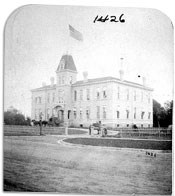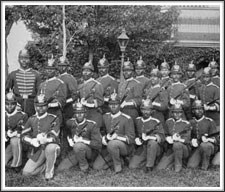
Minnesota Historical Society Divisions and DepartmentsFollowing the Civil War, the U.S. military shifted its focus to settling the West. In 1865, the Army established the Division of Missouri and placed its headquarters in St. Louis. The Division consisted of nearly all lands between the Mississippi River and the Rocky Mountains. Within the Division, four departments were created: the Department of Texas, the Department of the Missouri, the Department of the Platte, and the Department of Dakota. Each department was responsible for vast areas of unsettled territory, much of which was inhabited by American Indian tribes. Minnesota and the War DepartmentThough the Department of Dakota played a key role in the Plains Indian Wars, it also served many other functions. Troops from the Department protected railroad crews building the Northern Pacific Railroad and the workers who ran close to 2,000 miles of telegraph wire to various posts in the department. These tasks were accomplished while the Department was charged with protecting 375,000 square miles of territory. During the 1870's, the Department of Dakota commanded one-fifth of the U.S. Army's strength, but still argued for more troops. Pointing out that the Army's soldiers were deployed to 20 different forts and camps, General William T. Sherman argued that to reinforce the Department of Dakota any further would require stripping the entire American seaboard. The completion of the railroad and telegraph network helped to alleviate some of the strain and eliminated the need for a large system of forts. 
Minnesota Historical Society The Beginning of the Upper PostIn 1879, the headquarters for the Department of Dakota moved from St. Paul to the newly constructed Headquarters Building on the Upper Post. Many of the officers occupied the new homes on Officer's Row. Five years later, the Army opened four new barracks buildings across from Officer's Row, making room for a much larger garrison. Some of the first troops to use these facilities were the Buffalo Soldiers, the first all black infantry units in the U.S. Army. As the U.S. Army began consolidating its small and scattered posts into larger, more centralized forts, Fort Snelling's end seemed near. appeared among those that might be closed. Instead, the newly appointed Secretary of War, Alexander Ramsey, from Minnesota, ensured its survival and expansion. As territories became states, the Division of Missouri began dismantling many of the Departments. By the end of the 19th century, the Department of Dakota relocated to Chicago, Illinois, where it assumed a purely administrative function. However, the Department had established Fort's Snelling's value to the U.S. Army. |
Last updated: November 22, 2019
